Proven Fly Patterns for Alaska by Rich Johnson
Everyone has them… those few patterns that you just don’t leave home without. In most fisheries, those patterns would fit into a small fly box or two. But in Alaska, as always, everything is bigger. Considering we have such a short fishing season, it always amazes me how many different types of flies I need to have tied for the upcoming summer.

The primary reason for the wide range of fly patterns is our diverse fisheries. We’re blessed with five species of salmon that return from the sea each summer. Add to that our resident species of rainbow trout, Dolly Varden, and Arctic grayling. Throw in a couple of minor species like pike, lake trout, and whitefish; and don’t forget that we have steelhead runs, and it’s easy to see why a fly fisher’s eyes start to glaze over when talking about fly patterns for Alaska.
The first thing to do to keep from going into fly pattern overload is break down the where, when, and for what you’ll be fishing. Of the salmon, three species are popular targets: kings (Chinooks), reds (sockeyes), and silvers (cohos). The other two species, pinks (humpys) and chums (dog or calico) are often in the same rivers at the same time and often will take the same flies. Unfortunately both these fish switch to spawning mode fairly fast so they can become a bit of a nuisance when you are targeting bright fish and they will not stay off your fly. When targeting salmon, it’s important to find out the run timing for the species and area you’ll be fishing.
In almost any water where there are salmon, you’ll find Dolly Varden. Rainbows have a range from a bit north of Anchorage southward, with Arctic grayling ranging from a bit north of Anchorage northward. Their range overlaps in a few rivers throughout the state. The great thing about these species is that, for the most part, they’re available the entire season.
Species-Specific Pattern Principles
So let’s talk about a few examples of effective patterns. The following patterns are my versions of ones that I feel work well in fishing Alaska, and although it’s just a sampling, they’re flies that I carry and fish myself. Some of them are available commercially. The others… well, you’ll need to be a tyer or get to be friends with one to get an edge on the competition.
For king salmon think big and heavy, think movement and color. Kings ride the bottom of a river. Your fly should get down and stay down. And once on the bottom, it needs to have some movement and/or flash that will either pique the curiosity or rile the anger of your quarry. Use the best hooks you can afford, and keep them sharp. Kings have hard boney mouths and you usually will not get many chances to set a hook. A friend of mine uses pliers to tweak an offset in his hooks for kings. The Hareball Leech is a great example of a heavy, movement-type fly with its barbell eyes, rabbit fur body, and a bit of flash. And best of all, it’s really easy to tie. The Chartreuse Everglow is one of those patterns that’s been around for awhile, but is not shown in catalogs much anymore as “new & improved” sells better. Trust me, King salmon still like this fly. The Everglow is an example of where color (glow) seems to make a difference. Especially in water with limited visibility.
Sockeyes are an interesting salmon. By far the most popular salmon for sport fishermen, they can at times, be terribly tight-lipped when it comes to flies. Sockeyes are the least aggressive of all the salmon and do not chase and kill their food in the ocean. When choosing flies for these fish think small, sparse, shrimp-like, and almost a dead drift presentation. You do need to have your fly at their level so a pattern with some built-in weight helps a lot. The Green Lantern is a fairly new fly that has been very productive with bright fish. It showed up through the local fly shops a few years ago and now it flies off the bins in mid-June and July when the Sockeyes are running. The Mini-Krystal Shrimp was originally designed for bonefish, but ever since McAfee’s Fly Shop (now Mossy’s Fly Shop) bought a couple of dozen to see how they’d work they go through dozens every year. I modify my Mini-Krystal Shrimp with bead chain eyes for more built-in weight. Then I can use fewer split shot when I’m fishing. (Although both these flies are chartreuse, it’s not the only color that Sockeyes like; it just seems to be their favorite most of the time. Pink/tan combinations and orange with black or copper are other color schemes that can work when they turn off chartreuse.)
If sockeyes are the salmon of the masses, silvers are the salmon of the fly fishers. Averaging eight to twelve pounds, both aggressive and curious, silvers take to flies. Presentation and action seem to be key aspects for catching these salmon, although I have heard of them becoming very color specific at times. Silvers seem to prefer a jigging action, and a strip tease retrieve can trigger their interest. They’ll also run up and short strike at flies, which is one of the reasons why I’m showing the Gold Creek Special tied as a stinger style. (The other being that long-shanked hooks work against you once a fish is hooked. The long shank functions as a lever while you’re fighting a fish and actually helps the fish throw the hook.) The Gold Creek Special is a creation of Pat Welsh from Valdez and has proved itself in saltwater, where Pat fished it a lot, and in freshwater where most of us get to fish. It’s not hard to see where the design idea came from, and the only suggestion I’d have is to tie your flies with a couple of different size bead-chain eyes. I’ve been in a situation where my eyes were too heavy and my buddy Lance’s flies (with smaller bead chain eyes) were just right to keep the fly in the zone the Silvers wanted. The Starlight Leech was designed as a steelhead pattern but quickly made the transition to salmon. It’s heavy and really gets to the bottom fast when the fish are holding in deep runs. This is definitely a fly that needs a jigging retrieve. Its basic egg-head design is usually tied in green/black or pink/purple.
Rainbow trout, Dolly Varden, and Arctic grayling are available throughout the fishing season, and flies that work for each of them individually overlap quite a bit. To narrow down the choices to just a few that will fit into this space was tough. The ones I did choose represent a style or type of fly and are personal favorites of mine.
When smolts (or more accurately fry) are migrating downstream in the spring you want to be on the water fishing. Fry are the first real protein of the year and larger fish will lay in ambush as the pods of fry struggle with the current while moving downstream. Usually small and sparse, smolt/fry patterns work well from ice-out into summer. Even in July big fish seem to remember that little fish are tasty. The smolt pattern shown is simply a modified Clouser tied on a nickel hook and with an egg sack.
Once salmon start spawning and dying, eggs and flesh become an important source of protein for fish. The Veiled Egg represents an egg that’s been in the water long enough to become coated with fungus and is just different enough from a standard chenille egg to make a difference in your catch rate. This version of an egg pattern came from the Great Lakes area where it was used for steelhead. The name is the same, I simply downsized it a couple of notches and prefer a curved hook for a little more bite. It’s shown here wet so that you can see the translucency of the veil. In rivers where salmon are caught, filleted, and carcasses tossed back into the stream, flesh season starts as soon as the first salmon is caught. The Flesh Candy Cane is superb at mimicking a bit of meat starting to bleach out in the water. It’s my opinion that in rivers where salmon are caught and cleaned native fish “remember” flesh and eggs and will key in on these patterns even early in the year.
When it comes to insects, in Alaska, caddisflies are king. We have a few stoneflies and some mayflies, but all season long it's caddisflies that are your friend. The Tangle Lake Teaser is my personal take on a skittering caddis pattern. Even big rainbows will fall for a big dry when the conditions are right. The BH Prince Nymph needs no fanfare as it is great at suggesting a variety of bugs and is my go-to fly when fishing for grayling. In the bigger fly for bigger fish category, the Dolly Llama (also spelled Dalai Lama) is a favorite for many anglers. Tied in either olive/white or black/white this fly slinks in the water. Make it twitch during a swinging retrieve and keep the hook sharp. Most of the time the fish hook themselves on this bad boy.
Things to Remember
Salmon don’t eat once they enter freshwater so your flies for them need to incorporate silhouette, color and/or flash, and movement. You want to either trigger a feeding instinct or aggressive behavior. Consider the water you’ll be fishing and weight your flies accordingly.
For native species you’ll want to carry smolts, eggs, and flesh for any of the rivers that have salmon fishing. I’ve learned over the years always to have a few nymphs and dries with me for those rare occasions when the stars align and you have the opportunity to do some bug fishing.
In Conclusion
As a tyer I’m always tweaking patterns trying to figure out something that salmon will key into and the resident fish haven’t seen a thousand times, so most of these patterns have my personal touch on them. I believe that successful tyers (and fishermen) are flexible and know that a standard dressing is just a starting point, not the gospel written in stone. The flies shown here will get you pointed in the right direction. A little in-stream and online research and you too will have boxes full of proven Alaskan patterns.
Proven Patterns for Alaska – Recipes
Hareball Leech (or Hairball Leech)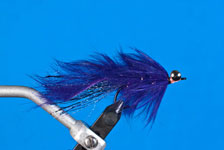
Hook: Standard Salmon, or your favorite
Weight: .030 or .035 lead
Thread: Black Flymaster Plus
Tail: Purple Rabbit Strip, with Grey Ghost (#21) Krystal Flash and purple Sparkleflash
Body: Purple Cactus Chenille, Large; palmered with purple rabbit strip.
Collar: Purple Schlappen
Eyes: Nickel Bright Eyes, 7/32”
Head: Hot Pink Flymaster Plus
Notes: This pattern has different color combinations
Everglow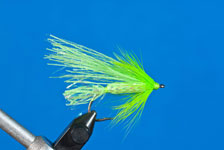
Hook: Straight eye, XStrong wire, or your favorite (Daiichi 2546/Dai-Riki #810/TMC 811S)
Weight: .030 or .035 Lead
Thread: Chartreuse Flymaster Plus
Tail: Frayed tubing from body
Underbody: Chenille or poly yarn over the lead wraps
Body: Everglow tubing, chartreuse
Underwing: Calf tail or bucktail (optional)
Wing: Everglow fibers, chartreuse
Collar: Saddle hackle, chartreuse
Notes: This pattern is tied in different colors
Green Lantern
Hook: Mustad 1197NS, size 6
Weight: Nickel Brite Bead, 3/16”
Thread: Chartreuse Flymaster Plus
Tail: #6962 Flashabou, Chartreuse dyed on pearl, short
Rear Body: #6962 Flashabou, wrapped over rear 2/3 of shank
Rib: Chartreuse Flymaster Plus, left long at start and counterwrapped over the rear body
Front Body: Chartreuse Cactus Chenille, Large
Mini-Krystal Shrimp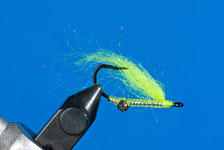
Hook: Gamakatsu L11S-3H, size 6; or your favorite bonefish hook
Thread: Chartreuse Uni-thread 8/0
Eyes: Silver Bead Chain, Medium
Under Body: #3061 Mirage, Fluorescent Yellow
Over Body: Medium D-Rib, Clear
Wing: Fluorescent Yellow Shimmer, or Chartreuse Ice Fur
Starlight Leech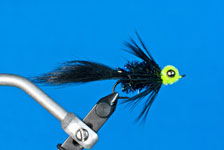
Hook: Standard Salmon or your favorite
Weight: .030 or .035 Lead wraps (optional)
Thread: Black (body) and Chartreuse (head) Flymaster Plus
Tail: Black Rabbit Strip
Body: Black Cactus Chenille, Large
Collar: Black Schlappen
Eyes: Nickel Bright Eyes, Large
Head: Chartreuse Chenille wrapped around eyes
Notes: This pattern has different color combinations
Gold Creek Special
Hook: Body – 3XL Streamer, size 4
Connection: Loop of 20lb FireLine, tied so stinger hook can be replaced
Stinger Hook: Owner #5111, size 4, looped into FireLine
Weight: .030 Lead wraps (optional)
Thread: Hot Pink Flymaster Plus
Tail: Hot Pink Rabbit strip with Pink Krystal Flash over
Body: Purple Rabbit strip, bunny style
Eyes: Silver Bead Chain, large or medium
Head: Hot Pink Flymaster Plus
(Break or cut off bend on body hook)
Marabou Clouser Fry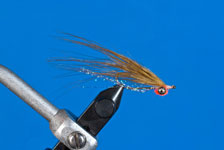
Hook: TMC 9394, or similar, size 8 or 10
Thread: White 6/0 Flymaster
Eyes: Silver Bead Chain, small for #10/ medium for #8
Belly: Grey Ghost (#21) Krystal Flash
Throat: Mixed Alaska Roe & Light Roe Glo-bug fibers, cut short
Wing: Olive Marabou fibers
Notes: This pattern is tied in different colors
Veiled Egg
Hook: Dai-Riki #135, or similar
Thread: White 6/0 Flymaster
Veil: Cream or Yellow Glo-bug Yarn, half thickness
Body: Shell Pink Chenille
Notes: This pattern is tied in different colors
Flesh Candy Cane
Hook: 3XLong Streamer
Weight: .030 Lead wraps
Thread: White Flymaster Plus
Body: Shell Pink Chenille, palmered with Flesh rabbit strip
Tangle Lake Teaser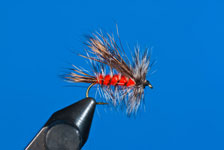
Hook: #12 or #14 Dry Fly
Thread: 6/0 Black Flymaster
Tail/underbody: Sitka Blacktail Deer hair (or coastal deer)
Body Hackle: Grizzly, one size under normal
Body: Orange Rabbit fur, or similar fine dubbing
Wing: Sitka Blacktail Deer hair (or costal deer)
Hackle: Grizzly
BH Prince Nymph
Hook: #12 or #14 2XLong Nymph
Weight: Brass Bead
Thread: Black 6/0 Flymaster
Tail: Brown Goose Biots, split
Rib: Gold Oval Tinsel, medium
Body: Peacock Herl
Collar: Brown dyed grizzly hen hackle
Wing: White Goose Biots, tied in a V over the top
Dolly Llama (or Dalai Lama)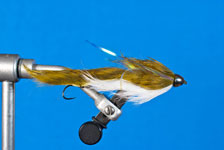
Stinger Hook: Owner #5111, size 4
Connection: 20lb FireLine
Body Hook: 3XL Streamer, size 2
Weight: Nickel Cone Head, 3/8”
Thread: Black Flymaster Plus
Tail: Olive Rabbit strip, tied to stinger hook
Body: Olive Rabbit strip, bunny style.
Belly: White Rabbit strip, as long as body
Sides: Saltwater Flashabou, pearl; two per side
(Break or cut off bend on body hook)
Notes: This pattern has different color combinations
Editor's Note: These patterns and many more are found in Alaska Flyfisher's "Fly Patterns of Alaska". Order your copy today!
